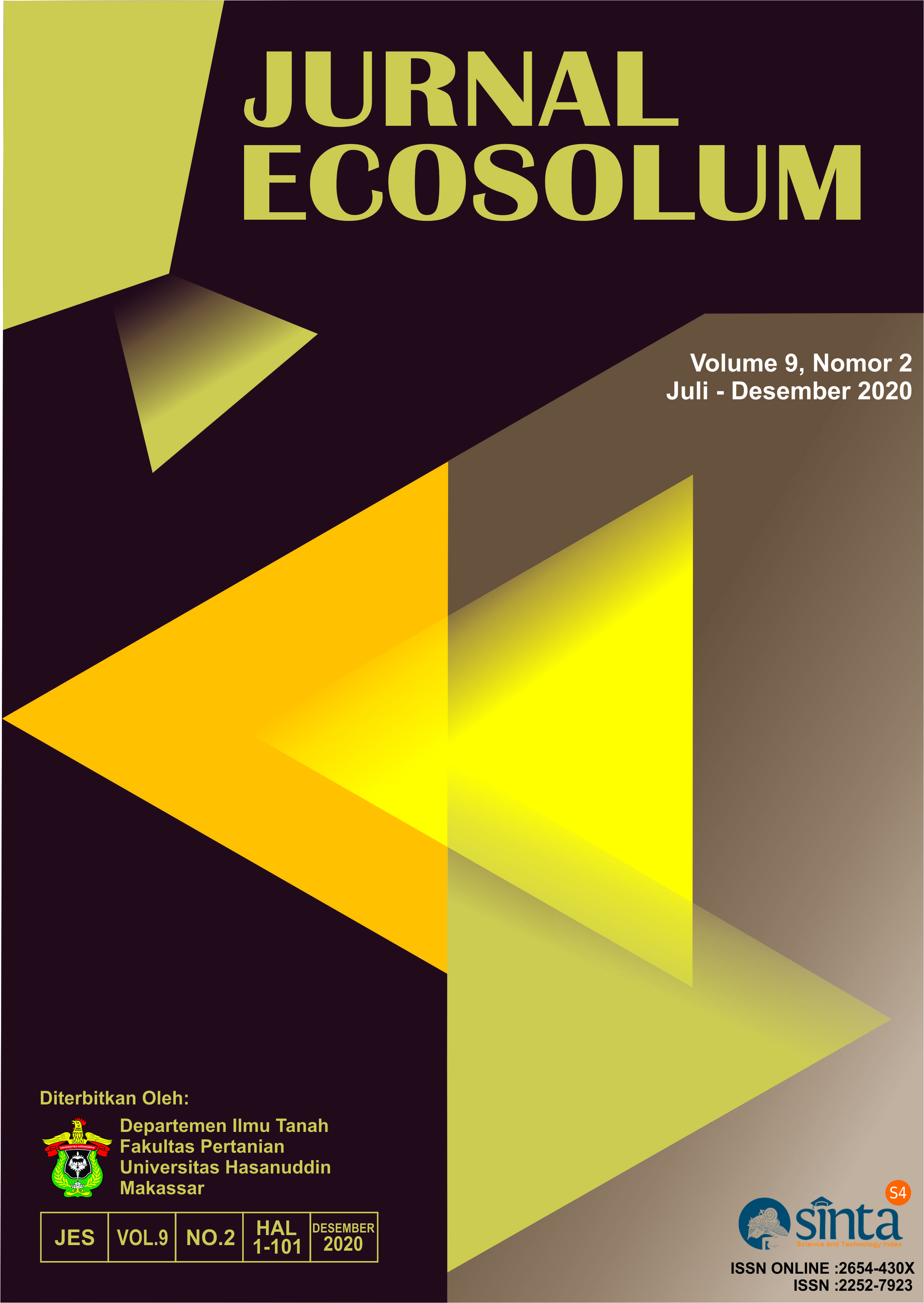Analisis Daya Dukung Lahan Pertanian (Sawah) Berdasarkan Hasil Produksi di Kecamatan Waeapo Kabupaten Buru
DOI:
https://doi.org/10.20956/ecosolum.v9i2.10975Keywords:
Land, Carrying Capacity, Waeapo DistrictAbstract
As the population continues to increase in an area, land requirements will also increase. The consequence will be that the population pressure on agricultural land is quite large and will ultimately reduce the output of agricultural production in the region. If this is allowed to continue it is not impossible that the production is not proportional to the food needs of the population. Thus it will cause the carrying capacity of agricultural land to be smaller.The purpose of this study is to analyze the effect of the carrying capacity of agricultural land (rice fields) on production results in Waeapo District, Buru Regency. The research method used was survey research with quantitative descriptive methods. Quantitative descriptive is an activity that is directed to measure or explain carefully certain phenomena or symptoms that are intended to test the truth in the field. The results showed that there were 3 (three) villages namely Savanajaya Village, Waetele Village and Waenetat Village whose carrying capacity of agricultural land (paddy) experienced a deficit (exceeded), while 3 (three) other villages namely Waekerta Village, Waekasar Village and Desa Wanareja carrying capacity of agricultural land has a surplus (sufficient). Thus there is a balance between land needs and the ability of land to provide food (especially rice) to meet the needs of residents in Waeapo District
References
Ariani, 2011. Identifikasi Potensi Sumberdaya Lahan untuk Pengembangan Lahan Pertanian Di Kabupaten Lombok Tengah. Jurnal Litbang PertanianVol. 25 No. 4 hal: 115-122
Baja, 2012. Metode Cepat Penghitungan Daya Dukung Lahan. Materi Latihann Perhitungan Daya Dukung Lahan. Universitas Hasanuddin
Badan Statistik Kabupaten Buru (BPS). 2019
fitriani. A. 2010. Analisis Daya Dukung Lahan Pertanian Dan Tekanan Penduduk (Studi Kasus Kabupaten Propinsi Jawa Timur Tahun 2003). Universitas Sebelas Maret Surakarta.
Hardjasoemantri. 2009. Hukum Tata Lingkungan. Edisi Ke-empat, Universitas Gajah Mada Press, Yogyakarta. Jurnal Teknologi Lingkungan, Vol. 2 No. 4, 2013, hal: 123-132
Kusnadi. 2012. Perencanaan Pembangunan Wilayah Berdasarkan Konsep Produktivitas Unggulan. Jurnal Teknologi Lingkungan, Vol. 8 No. 2, 2011, hal: 181-187.
Kementrian Negara Lingkungan Hidup. 2009. Permen LH No.17 Tahun 2009 Tentang :Pedoman Penentuan Daya Dukung Lingkungan Hidup dalam Penaatan Ruang Wilayah. Jakarta
Mantra.I. 2010. Pengantar Studi Demografi, Nur Cahaya, Yogyakarta
Moniaga, 2011. Analisis Daya Dukung Lahan Pertanian. Anatomical Sciences Education- Volume 7 No.2. Mei 2011
Mubyarto. 2011. Masyarakat Terasing 1994 – 1997 (kaji tindak IDT). Bsppenas: Jakarta
Ruslan, Widiatmono, dan Widyoseno. 2014. Rencana Tata Ruang Wilayah (RTRW) Berdasarkan Daya Dukung Lingkungan Berbasis Kemampuan Lahan. Jurnal Teknologi Pertanian vol.34. Malang: Fakultas Teknologi Pertanian Brawijaya.
Susanto, 2013. Analisis Daya Dukung Lingkungan Sektor Pertanian Berbasis Produktivitas di Kabupaten Bangli. Jurnal Bumi Lestari, Volume 13. No. 1. Februari 2013
Soehartono. 2010. Penelitian Sosial Ekonomi. Jakarta: Bumi Aksara. Jurnal Ekonomi dan Bisnis Universitas Udayana vol.5 No 3, 2016, hal : 387- 402
Undang-Undang Nomor 10 Tahun 2011 tentang Pengelolaan Pangan Berkekelanjutan
Widiatmaka, Ambarwulan, Purwanto, Setiawan, dan Effendi. 2015. Daya dukung Lingkungan Berbasis Kemampuan Lahan di Kabupaten Tuban, Propinsi Jawa Timur. Jurnal Manusia dan Lingkungan vol.22. Bogor. Fakultas Pertanian IPB.
Downloads
Published
How to Cite
Issue
Section
License
Copyright (c) 2020 Jurnal Ecosolum

This work is licensed under a Creative Commons Attribution-NonCommercial 4.0 International License.












